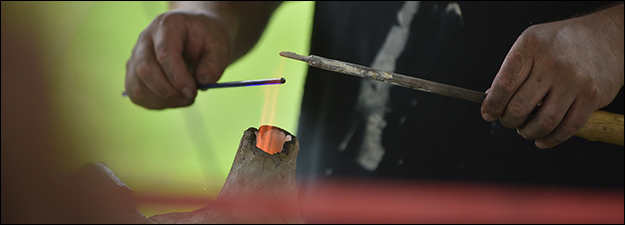Re-thinking the Wearable in the Middle Ages
Sponsoring Organization(s)
Special Session
Organizer Name
Elizabeth Dospel Williams, Ittai Weinryb
Organizer Affiliation
Dumbarton Oaks Research Library and Collection, Bard Graduate Center
Presider Name
Elizabeth Dospel Williams, Ittai Weinryb
Paper Title 1
Bodies on Garments: "Social Skin," Architecture, and Identity on Coptic Textiles in Japan
Presenter 1 Name
Andrea Olsen Lam
Presenter 1 Affiliation
Independent Scholar
Paper Title 2
The "Staurotheke of Gaeta": A Divine Shield against Evil
Presenter 2 Name
Pietro Pirrone
Presenter 2 Affiliation
Univ. degli Studi di Salerno
Paper Title 3
Christian Flare: Adorning the Body and Rethinking Jet Amulets
Presenter 3 Name
Stephanie Chapman
Presenter 3 Affiliation
Univ. of Missouri-Columbia
Paper Title 4
Sumptuary Laws and Material Elegance: Import Textiles and Sienese Painting
Presenter 4 Name
Jasmin W. Cyril
Presenter 4 Affiliation
Benedict College
Start Date
12-5-2016 7:30 PM
Session Location
Schneider 1120
Description
Covering, protecting, and adorning the body count among the most fundamental of human concerns, at once conveying aspects of an individual’s persona while also situating a person within a given social context. Wearable adornment encompasses materials fashioned by human hands (like fabric, metalwork, or even animal bones) and modifications to the body itself (such as tattoos, cosmetics, or hairstyles), which beautify the body while simultaneously conveying social, political and protective functions and meanings. The wearable is thus the most representational and at the same time most intimate product of material culture.
This session seeks to expand our current understanding of the wearable in the Middle Ages. Current scholarship on the topic in western medieval, Byzantine, and Islamic traditions tends to encompass clothing and jewelry, and is frequently medium-specific, with minimal regard to the interrelatedness of different aspects of appearance. On the one hand, work on medieval textiles approaches questions of identity, consumption, and appearance by comparing textual sources and visual depictions with surviving textiles. The study of medieval jewelry, on the other hand, largely focuses on the classification and attribution of precious metal pieces from excavations and museum collections, as scholars make sense of pieces long removed from the bodies they once adorned. Tattoos, prosthetics, cosmetics and headgear are almost entirely absent in our understandings of medieval dress practices. This separation was not always so, however, and indeed nineteenth-century art historians such as Gottfried Semper integrated all aspects of bodily adornment in their considerations of the nature of ornamentation and surface decoration.
In this session we would like to reimagine the wearable in similarly holistic terms. Bringing together varied forms and different media will help scholars better understand how the surfaces of medieval bodies not only presented social values and norms, but also operated within a designated spatial environment. The session looks past field- and medium-specific divisions to explore the relationship of textiles and jewelry in western and eastern medieval traditions. We will consider cosmetic elements often omitted from discussions of dress, such as makeup, tattooing, amulets, prosthetics, and any other modifications to personal appearance. Papers will situate dressed bodies in their spatial contexts to address medieval notions of personal space and the relationship of bodies to their surroundings. Lastly, the session considers issues of medium-specificity and materiality, as concerns that arise directly from questions regarding the wearable. Papers consider the centrality or marginality of image-making within the practice of the wearable, as well as the reception of the wearable as part of a sensory experience.
Re-thinking the Wearable in the Middle Ages
Schneider 1120
Covering, protecting, and adorning the body count among the most fundamental of human concerns, at once conveying aspects of an individual’s persona while also situating a person within a given social context. Wearable adornment encompasses materials fashioned by human hands (like fabric, metalwork, or even animal bones) and modifications to the body itself (such as tattoos, cosmetics, or hairstyles), which beautify the body while simultaneously conveying social, political and protective functions and meanings. The wearable is thus the most representational and at the same time most intimate product of material culture.
This session seeks to expand our current understanding of the wearable in the Middle Ages. Current scholarship on the topic in western medieval, Byzantine, and Islamic traditions tends to encompass clothing and jewelry, and is frequently medium-specific, with minimal regard to the interrelatedness of different aspects of appearance. On the one hand, work on medieval textiles approaches questions of identity, consumption, and appearance by comparing textual sources and visual depictions with surviving textiles. The study of medieval jewelry, on the other hand, largely focuses on the classification and attribution of precious metal pieces from excavations and museum collections, as scholars make sense of pieces long removed from the bodies they once adorned. Tattoos, prosthetics, cosmetics and headgear are almost entirely absent in our understandings of medieval dress practices. This separation was not always so, however, and indeed nineteenth-century art historians such as Gottfried Semper integrated all aspects of bodily adornment in their considerations of the nature of ornamentation and surface decoration.
In this session we would like to reimagine the wearable in similarly holistic terms. Bringing together varied forms and different media will help scholars better understand how the surfaces of medieval bodies not only presented social values and norms, but also operated within a designated spatial environment. The session looks past field- and medium-specific divisions to explore the relationship of textiles and jewelry in western and eastern medieval traditions. We will consider cosmetic elements often omitted from discussions of dress, such as makeup, tattooing, amulets, prosthetics, and any other modifications to personal appearance. Papers will situate dressed bodies in their spatial contexts to address medieval notions of personal space and the relationship of bodies to their surroundings. Lastly, the session considers issues of medium-specificity and materiality, as concerns that arise directly from questions regarding the wearable. Papers consider the centrality or marginality of image-making within the practice of the wearable, as well as the reception of the wearable as part of a sensory experience.


